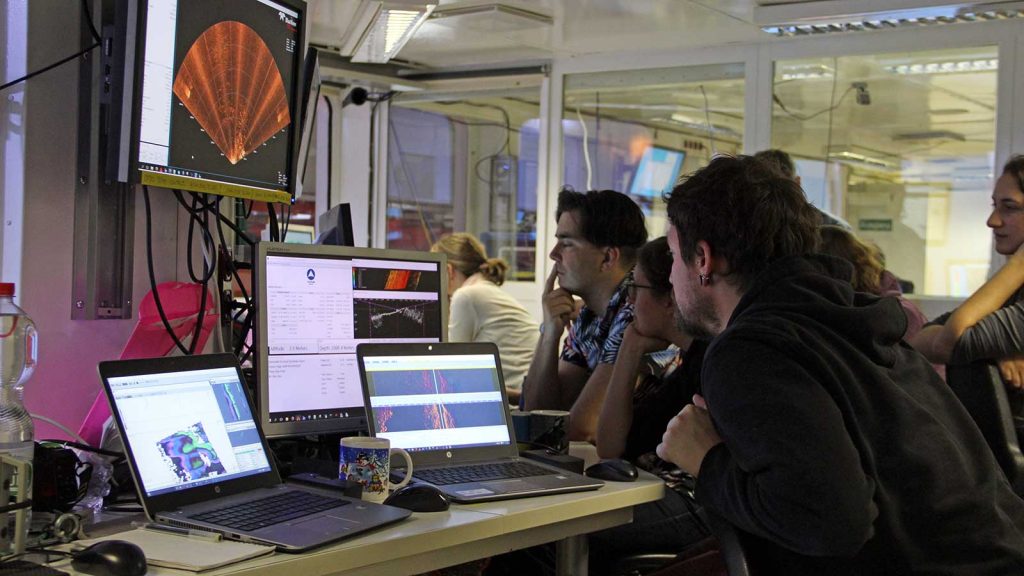
Deep thoughts. My partners in crime from the OFOS camera surveys over the deep vent area (left to right): Autun, Paulina, and Simon—all completely engrossed in the scenes coming from our live feeds as the camera passed over regions of the Arctic seafloor that have never been seen before. (photo by Chris German, Woods Hole Oceanographic Institution)
Whatever our deep site gets called, it won’t be named Mount Brexit. But it also continues to perplex us.
After the two OFOS dives late Monday and again on Tuesday afternoon, we believe we have closed in on our site of active venting. We haven’t laid eyes on hot water gushing from the seafloor yet, but we have seen chimney-like structures rising up from the seabed, poking through sediments, and landscapes of multicolored sediments draped up against steep, cliff-like rock faces.
It’s way prettier than an ordinary black smoker, whatever it is that still eludes us down there. If you ever had the chance to visit Yellowstone National Park then I would describe our brief fly-by as akin to passing close over the Norris Geyser Basin in a hot air balloon in the dark with only a searchlight to view things below you.
As marvelous as what you are looking at, you are moving so fast that you are worried you don’t have time to take it all in. And the edge of your field of view, where the light runs out, only offers even more tantalizing clues what might be just out of reach. It’s fascinating, rewarding, and frustrating all at the same time.
And all the while the countdown clock keeps tick tick tick tick tick tick ticking.
Indeed, we almost didn’t get the second chance to use OFOS at all. You might recall that in the last post, we had been told there was one more chance for OFOS—but that dive went really well and we saw dead chimneys, some massive cliff drop-offs, and, after the fact, found that our data loggers had recorded strong temperature anomalies just as we passed over those cliffs. We are pretty sure now that they are caused by geologic fractures that must also be providing the conduits for hot water flow.
But today was meant to be all about sampling the plume, the rocks, and the sediments in the area. The trouble is, the ship’s central computer system that controls all the winches broke down around 11:00 a.m. and by 2:00 p.m., it still wasn’t working. We were marooned, stuck in the ice and powerless to deploy any science equipment. Or were we?
It turns out we had a spare winch and cable on the back deck that wasn’t powered through the ship’s central computer, so we COULD use that. Unfortunately, it only had 3200 meters (10,500 feet) of wire on it and we think our we believe, are at 3150-3200 meters depth. But it’s better than doing nothing. So, we transferred OFOS across to that cable and lowered away.
The drift of the ship worked out pretty well and by mid-afternoon we were heading on an east-west crossing line headed to intersect the previous day’s north-south track right where we’d found the extinct chimneys. The trouble is, the ship was being pushed along so fast by the ice that the drag on the cable meant that OFOS was being streamed out at an increasingly sharp angle behind us—and every meter of lay-back behind the ship stole precious depth from us.
Just as we approached the area we cared most about, we began to see brightly colored staining on the seafloor again. But then, as we got closest to a location where, once again, we recorded our strongest temperature anomalies of the dive, OFOS swung out over the top of a cliff face and the seabed disappeared out of view beneath us.
Could we go down just another five meters to see what was happening at the bottom of the cliff? No, came the answer from the chief mate, who was standing by to keep a close eye on things. We had literally met the end of our tether.
As the ship drove along a near perfect course following the contour lines we wanted from east to west, we were left stranded in mid-water, looking at a blank screen and wondering what might lay just beyond our sight.
Eventually the ship swung far enough to south that the seafloor came back into view of the OFOS cameras, but by then we were out of time and too far east, anyway. So be it. It was time to switch to other operations so that everybody has a complete set of the samples that they wanted from the overlying plume (we are getting very good at that).
Next, we’re off to Karasik Seamount to finish operations there and, if we are really, really lucky, we’ll have enough time to stop off at Mt Perplexion one last time on our way home. So far, we’re close, no cigar (yet)!

